[English] 日本語
 Yorodumi
Yorodumi- PDB-5i0i: Crystal structure of myosin X motor domain with 2IQ motifs in pre... -
+ Open data
Open data
- Basic information
Basic information
| Entry | Database: PDB / ID: 5i0i | |||||||||||||||||||||
|---|---|---|---|---|---|---|---|---|---|---|---|---|---|---|---|---|---|---|---|---|---|---|
| Title | Crystal structure of myosin X motor domain with 2IQ motifs in pre-powerstroke state | |||||||||||||||||||||
 Components Components |
| |||||||||||||||||||||
 Keywords Keywords | MOTOR PROTEIN / myosin / motor domain / molecular motor / pre-powerstrocke state / motility | |||||||||||||||||||||
| Function / homology |  Function and homology information Function and homology informationplus-end directed microfilament motor activity / Netrin-1 signaling / positive regulation of cell-cell adhesion / filopodium tip / : / cytoskeleton-dependent intracellular transport / regulation of filopodium assembly / establishment of protein localization to mitochondrial membrane / type 3 metabotropic glutamate receptor binding / filopodium membrane ...plus-end directed microfilament motor activity / Netrin-1 signaling / positive regulation of cell-cell adhesion / filopodium tip / : / cytoskeleton-dependent intracellular transport / regulation of filopodium assembly / establishment of protein localization to mitochondrial membrane / type 3 metabotropic glutamate receptor binding / filopodium membrane / myosin complex / CaM pathway / Cam-PDE 1 activation / Sodium/Calcium exchangers / Calmodulin induced events / regulation of synaptic vesicle endocytosis / Reduction of cytosolic Ca++ levels / CREB1 phosphorylation through the activation of CaMKII/CaMKK/CaMKIV cascasde / Activation of Ca-permeable Kainate Receptor / Loss of phosphorylation of MECP2 at T308 / CREB1 phosphorylation through the activation of Adenylate Cyclase / PKA activation / negative regulation of high voltage-gated calcium channel activity / CaMK IV-mediated phosphorylation of CREB / Glycogen breakdown (glycogenolysis) / positive regulation of cyclic-nucleotide phosphodiesterase activity / regulation of synaptic vesicle exocytosis / organelle localization by membrane tethering / negative regulation of calcium ion export across plasma membrane / CLEC7A (Dectin-1) induces NFAT activation / mitochondrion-endoplasmic reticulum membrane tethering / autophagosome membrane docking / microfilament motor activity / regulation of cardiac muscle cell action potential / Activation of RAC1 downstream of NMDARs / spectrin binding / response to corticosterone / positive regulation of DNA binding / positive regulation of ryanodine-sensitive calcium-release channel activity / nitric-oxide synthase binding / regulation of cell communication by electrical coupling involved in cardiac conduction / Negative regulation of NMDA receptor-mediated neuronal transmission / negative regulation of peptidyl-threonine phosphorylation / Synthesis of IP3 and IP4 in the cytosol / Unblocking of NMDA receptors, glutamate binding and activation / Phase 0 - rapid depolarisation / negative regulation of ryanodine-sensitive calcium-release channel activity / protein phosphatase activator activity / RHO GTPases activate PAKs / phosphatidylinositol-3,4,5-trisphosphate binding / : / Ion transport by P-type ATPases / Long-term potentiation / Uptake and function of anthrax toxins / Regulation of MECP2 expression and activity / Calcineurin activates NFAT / adenylate cyclase binding / catalytic complex / DARPP-32 events / detection of calcium ion / regulation of cardiac muscle contraction / regulation of ryanodine-sensitive calcium-release channel activity / Smooth Muscle Contraction / cellular response to interferon-beta / RHO GTPases activate IQGAPs / regulation of cardiac muscle contraction by regulation of the release of sequestered calcium ion / calcium channel inhibitor activity / Protein methylation / phosphatidylinositol 3-kinase binding / eNOS activation / enzyme regulator activity / activation of adenylate cyclase activity / regulation of release of sequestered calcium ion into cytosol by sarcoplasmic reticulum / Activation of AMPK downstream of NMDARs / Tetrahydrobiopterin (BH4) synthesis, recycling, salvage and regulation / : / Ion homeostasis / titin binding / regulation of calcium-mediated signaling / positive regulation of protein autophosphorylation / voltage-gated potassium channel complex / sperm midpiece / ruffle / calcium channel complex / response to amphetamine / substantia nigra development / adenylate cyclase activator activity / Ras activation upon Ca2+ influx through NMDA receptor / nitric-oxide synthase regulator activity / regulation of heart rate / sarcomere / FCERI mediated Ca+2 mobilization / protein serine/threonine kinase activator activity / FCGR3A-mediated IL10 synthesis / VEGFR2 mediated vascular permeability / Antigen activates B Cell Receptor (BCR) leading to generation of second messengers / VEGFR2 mediated cell proliferation / regulation of cytokinesis / positive regulation of peptidyl-threonine phosphorylation / positive regulation of nitric-oxide synthase activity Similarity search - Function | |||||||||||||||||||||
| Biological species |  Homo sapiens (human) Homo sapiens (human) | |||||||||||||||||||||
| Method |  X-RAY DIFFRACTION / X-RAY DIFFRACTION /  SYNCHROTRON / SYNCHROTRON /  MOLECULAR REPLACEMENT / Resolution: 3.15 Å MOLECULAR REPLACEMENT / Resolution: 3.15 Å | |||||||||||||||||||||
 Authors Authors | Isabet, T. / Sweeney, H.L. / Houdusse, A. | |||||||||||||||||||||
| Funding support |  France, France,  United States, 6items United States, 6items
| |||||||||||||||||||||
 Citation Citation |  Journal: Nat Commun / Year: 2016 Journal: Nat Commun / Year: 2016Title: The myosin X motor is optimized for movement on actin bundles. Authors: Virginie Ropars / Zhaohui Yang / Tatiana Isabet / Florian Blanc / Kaifeng Zhou / Tianming Lin / Xiaoyan Liu / Pascale Hissier / Frédéric Samazan / Béatrice Amigues / Eric D Yang / Hyokeun ...Authors: Virginie Ropars / Zhaohui Yang / Tatiana Isabet / Florian Blanc / Kaifeng Zhou / Tianming Lin / Xiaoyan Liu / Pascale Hissier / Frédéric Samazan / Béatrice Amigues / Eric D Yang / Hyokeun Park / Olena Pylypenko / Marco Cecchini / Charles V Sindelar / H Lee Sweeney / Anne Houdusse /    Abstract: Myosin X has features not found in other myosins. Its structure must underlie its unique ability to generate filopodia, which are essential for neuritogenesis, wound healing, cancer metastasis and ...Myosin X has features not found in other myosins. Its structure must underlie its unique ability to generate filopodia, which are essential for neuritogenesis, wound healing, cancer metastasis and some pathogenic infections. By determining high-resolution structures of key components of this motor, and characterizing the in vitro behaviour of the native dimer, we identify the features that explain the myosin X dimer behaviour. Single-molecule studies demonstrate that a native myosin X dimer moves on actin bundles with higher velocities and takes larger steps than on single actin filaments. The largest steps on actin bundles are larger than previously reported for artificially dimerized myosin X constructs or any other myosin. Our model and kinetic data explain why these large steps and high velocities can only occur on bundled filaments. Thus, myosin X functions as an antiparallel dimer in cells with a unique geometry optimized for movement on actin bundles. | |||||||||||||||||||||
| History |
|
- Structure visualization
Structure visualization
| Structure viewer | Molecule:  Molmil Molmil Jmol/JSmol Jmol/JSmol |
|---|
- Downloads & links
Downloads & links
- Download
Download
| PDBx/mmCIF format |  5i0i.cif.gz 5i0i.cif.gz | 794.6 KB | Display |  PDBx/mmCIF format PDBx/mmCIF format |
|---|---|---|---|---|
| PDB format |  pdb5i0i.ent.gz pdb5i0i.ent.gz | 653.1 KB | Display |  PDB format PDB format |
| PDBx/mmJSON format |  5i0i.json.gz 5i0i.json.gz | Tree view |  PDBx/mmJSON format PDBx/mmJSON format | |
| Others |  Other downloads Other downloads |
-Validation report
| Arichive directory |  https://data.pdbj.org/pub/pdb/validation_reports/i0/5i0i https://data.pdbj.org/pub/pdb/validation_reports/i0/5i0i ftp://data.pdbj.org/pub/pdb/validation_reports/i0/5i0i ftp://data.pdbj.org/pub/pdb/validation_reports/i0/5i0i | HTTPS FTP |
|---|
-Related structure data
- Links
Links
- Assembly
Assembly
| Deposited unit | 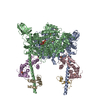
| ||||||||
|---|---|---|---|---|---|---|---|---|---|
| 1 | 
| ||||||||
| 2 | 
| ||||||||
| Unit cell |
|
- Components
Components
-Protein , 4 types, 5 molecules ABCEI
| #1: Protein | Mass: 91550.148 Da / Num. of mol.: 2 Source method: isolated from a genetically manipulated source Source: (gene. exp.)  Homo sapiens (human) / Gene: MYO10, KIAA0799 / Production host: Homo sapiens (human) / Gene: MYO10, KIAA0799 / Production host:  unidentified baculovirus / References: UniProt: Q9HD67 unidentified baculovirus / References: UniProt: Q9HD67#2: Protein | | Mass: 16450.014 Da / Num. of mol.: 1 Source method: isolated from a genetically manipulated source Source: (gene. exp.)  Homo sapiens (human) Homo sapiens (human)Gene: CALM1, CALM, CAM, CAM1, CALM2, CAM2, CAMB, CALM3, CALML2, CAM3, CAMC, CAMIII Production host:  unidentified baculovirus / References: UniProt: P62158, UniProt: P0DP23*PLUS unidentified baculovirus / References: UniProt: P62158, UniProt: P0DP23*PLUS#3: Protein | | Mass: 16373.917 Da / Num. of mol.: 1 Source method: isolated from a genetically manipulated source Source: (gene. exp.)  Homo sapiens (human) Homo sapiens (human)Gene: CALM1, CALM, CAM, CAM1, CALM2, CAM2, CAMB, CALM3, CALML2, CAM3, CAMC, CAMIII Production host:  unidentified baculovirus / References: UniProt: P62158, UniProt: P0DP23*PLUS unidentified baculovirus / References: UniProt: P62158, UniProt: P0DP23*PLUS#5: Protein | | Mass: 7408.098 Da / Num. of mol.: 1 Source method: isolated from a genetically manipulated source Source: (gene. exp.)  Homo sapiens (human) Homo sapiens (human)Gene: CALM1, CALM, CAM, CAM1, CALM2, CAM2, CAMB, CALM3, CALML2, CAM3, CAMC, CAMIII Production host:  unidentified baculovirus / References: UniProt: P62158, UniProt: P0DP23*PLUS unidentified baculovirus / References: UniProt: P62158, UniProt: P0DP23*PLUS |
|---|
-Protein/peptide , 1 types, 1 molecules G
| #4: Protein/peptide | Mass: 4977.496 Da / Num. of mol.: 1 Source method: isolated from a genetically manipulated source Source: (gene. exp.)  Homo sapiens (human) Homo sapiens (human)Gene: CALM1, CALM, CAM, CAM1, CALM2, CAM2, CAMB, CALM3, CALML2, CAM3, CAMC, CAMIII Production host:  unidentified baculovirus / References: UniProt: P62158, UniProt: P0DP23*PLUS unidentified baculovirus / References: UniProt: P62158, UniProt: P0DP23*PLUS |
|---|
-Non-polymers , 6 types, 32 molecules 

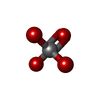








| #6: Chemical | | #7: Chemical | #8: Chemical | #9: Chemical | #10: Chemical | ChemComp-SO4 / #11: Water | ChemComp-HOH / | |
|---|
-Experimental details
-Experiment
| Experiment | Method:  X-RAY DIFFRACTION / Number of used crystals: 1 X-RAY DIFFRACTION / Number of used crystals: 1 |
|---|
- Sample preparation
Sample preparation
| Crystal | Density Matthews: 3.84 Å3/Da / Density % sol: 68 % |
|---|---|
| Crystal grow | Temperature: 277 K / Method: vapor diffusion, hanging drop / pH: 7 Details: 7.5% PEG 10000, 100mM MOPS pH 7.0, 1mM TCEP and 50mM Magnesium acetate |
-Data collection
| Diffraction | Mean temperature: 100 K |
|---|---|
| Diffraction source | Source:  SYNCHROTRON / Site: SYNCHROTRON / Site:  SOLEIL SOLEIL  / Beamline: PROXIMA 1 / Wavelength: 0.9801 Å / Beamline: PROXIMA 1 / Wavelength: 0.9801 Å |
| Detector | Type: DECTRIS PILATUS 6M / Detector: PIXEL / Date: Apr 9, 2013 |
| Radiation | Protocol: SINGLE WAVELENGTH / Monochromatic (M) / Laue (L): M / Scattering type: x-ray |
| Radiation wavelength | Wavelength: 0.9801 Å / Relative weight: 1 |
| Reflection | Resolution: 3.15→50 Å / Num. obs: 61853 / % possible obs: 99.9 % / Redundancy: 16.9 % / Biso Wilson estimate: 118.26 Å2 / Net I/σ(I): 14.48 |
| Reflection shell | Resolution: 3.15→3.23 Å / Redundancy: 16.8 % / Mean I/σ(I) obs: 1.15 / % possible all: 99.7 |
- Processing
Processing
| Software |
| |||||||||||||||||||||||||||||||||||||||||||||||||||||||||||||||||||||||||||||||||||||||||||||||||||||||||||||||||||||||||||||||||||||||||||||||||||||||||||||||||||||||||||||||
|---|---|---|---|---|---|---|---|---|---|---|---|---|---|---|---|---|---|---|---|---|---|---|---|---|---|---|---|---|---|---|---|---|---|---|---|---|---|---|---|---|---|---|---|---|---|---|---|---|---|---|---|---|---|---|---|---|---|---|---|---|---|---|---|---|---|---|---|---|---|---|---|---|---|---|---|---|---|---|---|---|---|---|---|---|---|---|---|---|---|---|---|---|---|---|---|---|---|---|---|---|---|---|---|---|---|---|---|---|---|---|---|---|---|---|---|---|---|---|---|---|---|---|---|---|---|---|---|---|---|---|---|---|---|---|---|---|---|---|---|---|---|---|---|---|---|---|---|---|---|---|---|---|---|---|---|---|---|---|---|---|---|---|---|---|---|---|---|---|---|---|---|---|---|---|---|---|
| Refinement | Method to determine structure:  MOLECULAR REPLACEMENT / Resolution: 3.15→49.53 Å / Cor.coef. Fo:Fc: 0.9356 / Cor.coef. Fo:Fc free: 0.9334 / SU R Cruickshank DPI: 3.519 / Cross valid method: THROUGHOUT / σ(F): 0 / SU R Blow DPI: 1.802 / SU Rfree Blow DPI: 0.333 / SU Rfree Cruickshank DPI: 0.342 MOLECULAR REPLACEMENT / Resolution: 3.15→49.53 Å / Cor.coef. Fo:Fc: 0.9356 / Cor.coef. Fo:Fc free: 0.9334 / SU R Cruickshank DPI: 3.519 / Cross valid method: THROUGHOUT / σ(F): 0 / SU R Blow DPI: 1.802 / SU Rfree Blow DPI: 0.333 / SU Rfree Cruickshank DPI: 0.342
| |||||||||||||||||||||||||||||||||||||||||||||||||||||||||||||||||||||||||||||||||||||||||||||||||||||||||||||||||||||||||||||||||||||||||||||||||||||||||||||||||||||||||||||||
| Displacement parameters | Biso mean: 126.34 Å2
| |||||||||||||||||||||||||||||||||||||||||||||||||||||||||||||||||||||||||||||||||||||||||||||||||||||||||||||||||||||||||||||||||||||||||||||||||||||||||||||||||||||||||||||||
| Refine analyze | Luzzati coordinate error obs: 0.383 Å | |||||||||||||||||||||||||||||||||||||||||||||||||||||||||||||||||||||||||||||||||||||||||||||||||||||||||||||||||||||||||||||||||||||||||||||||||||||||||||||||||||||||||||||||
| Refinement step | Cycle: LAST / Resolution: 3.15→49.53 Å
| |||||||||||||||||||||||||||||||||||||||||||||||||||||||||||||||||||||||||||||||||||||||||||||||||||||||||||||||||||||||||||||||||||||||||||||||||||||||||||||||||||||||||||||||
| Refine LS restraints |
| |||||||||||||||||||||||||||||||||||||||||||||||||||||||||||||||||||||||||||||||||||||||||||||||||||||||||||||||||||||||||||||||||||||||||||||||||||||||||||||||||||||||||||||||
| LS refinement shell | Resolution: 3.15→3.23 Å / Total num. of bins used: 20
| |||||||||||||||||||||||||||||||||||||||||||||||||||||||||||||||||||||||||||||||||||||||||||||||||||||||||||||||||||||||||||||||||||||||||||||||||||||||||||||||||||||||||||||||
| Refinement TLS params. | Method: refined / Refine-ID: X-RAY DIFFRACTION
| |||||||||||||||||||||||||||||||||||||||||||||||||||||||||||||||||||||||||||||||||||||||||||||||||||||||||||||||||||||||||||||||||||||||||||||||||||||||||||||||||||||||||||||||
| Refinement TLS group |
|
 Movie
Movie Controller
Controller






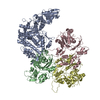
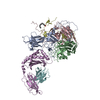
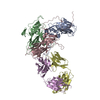

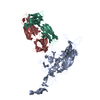



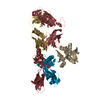

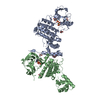
 PDBj
PDBj































